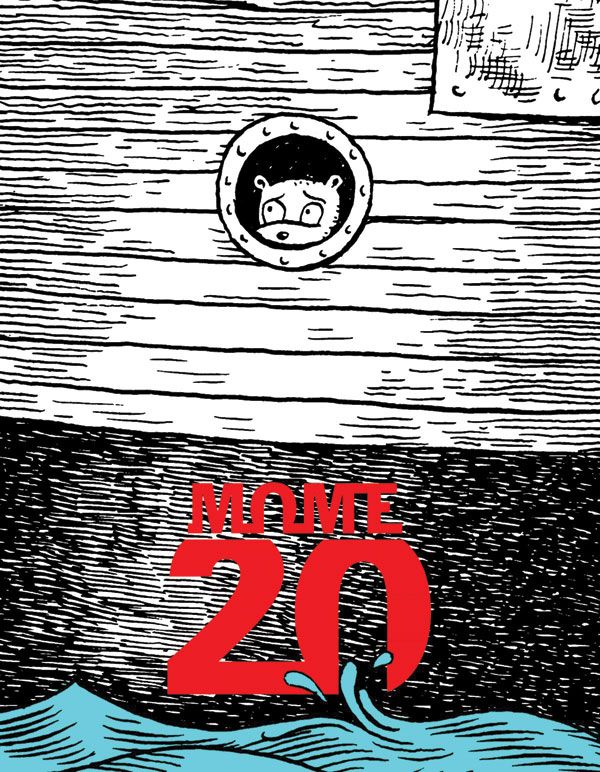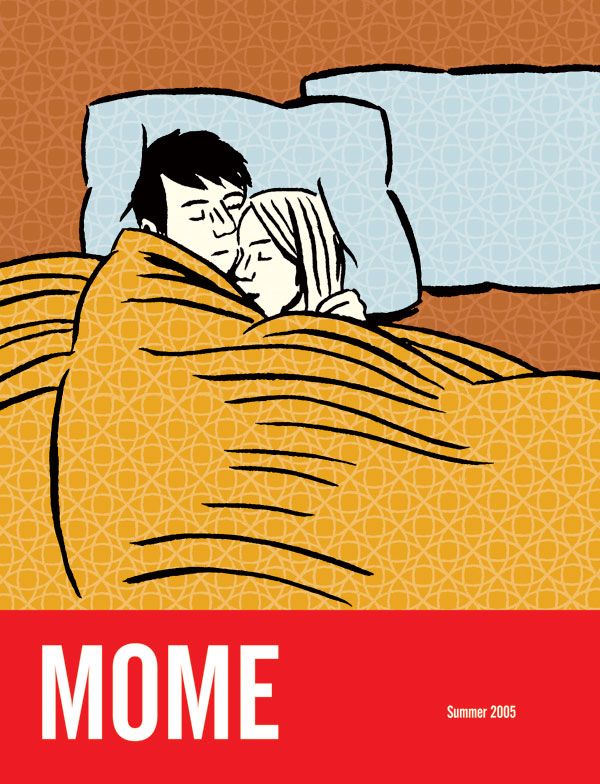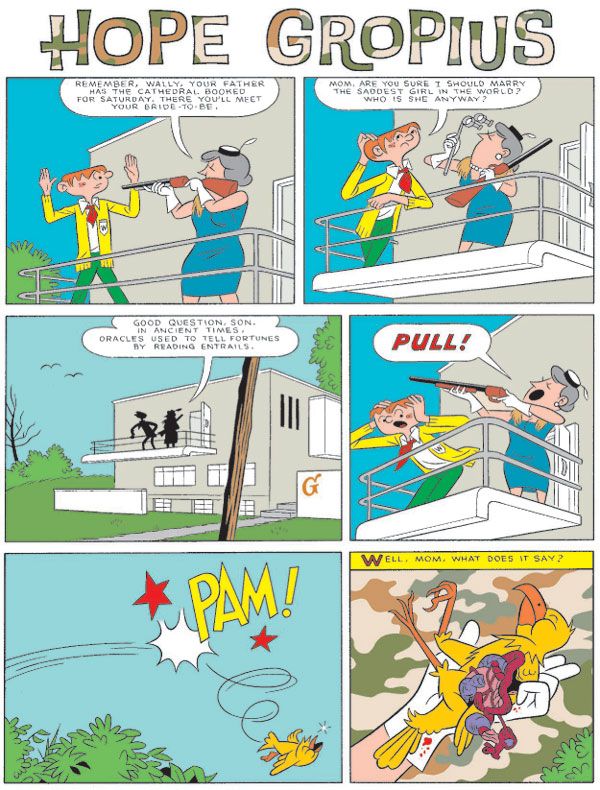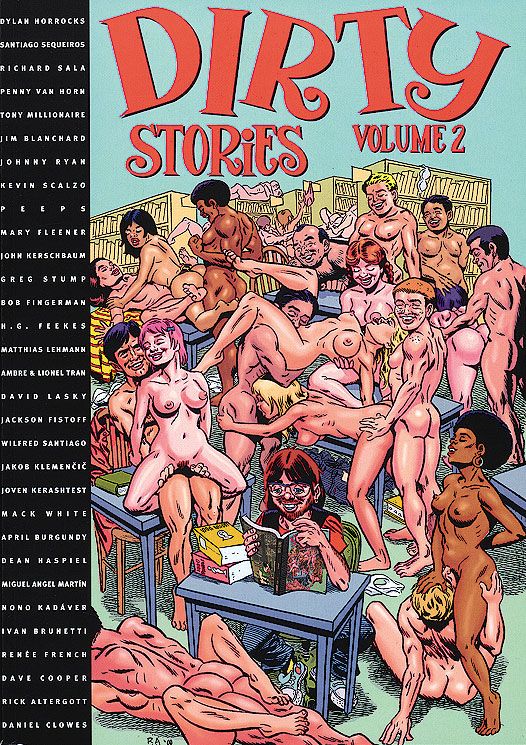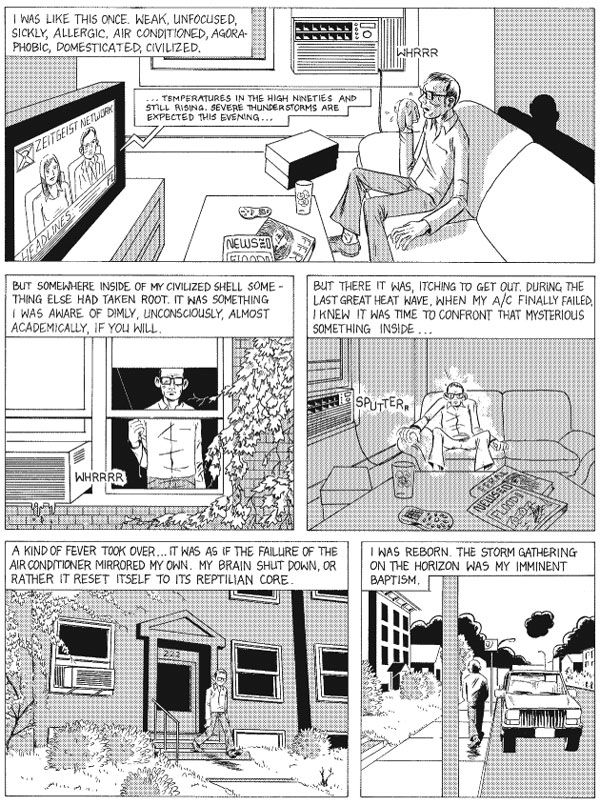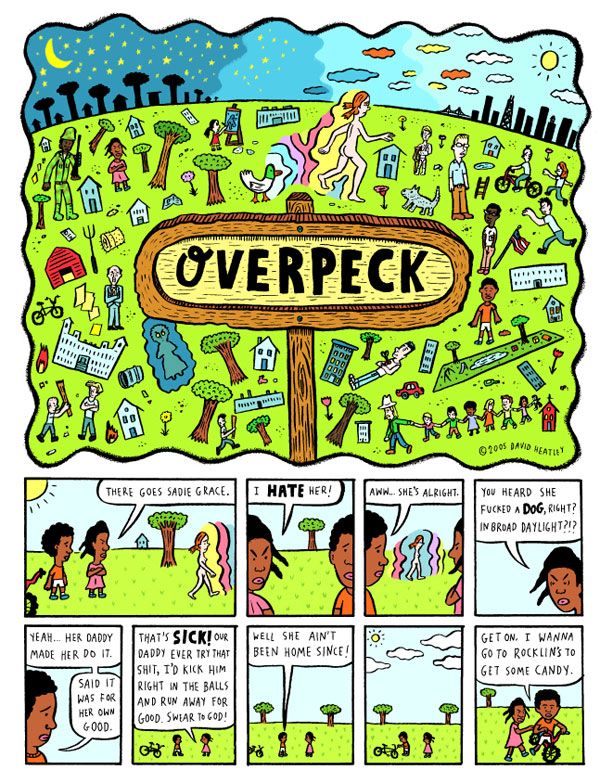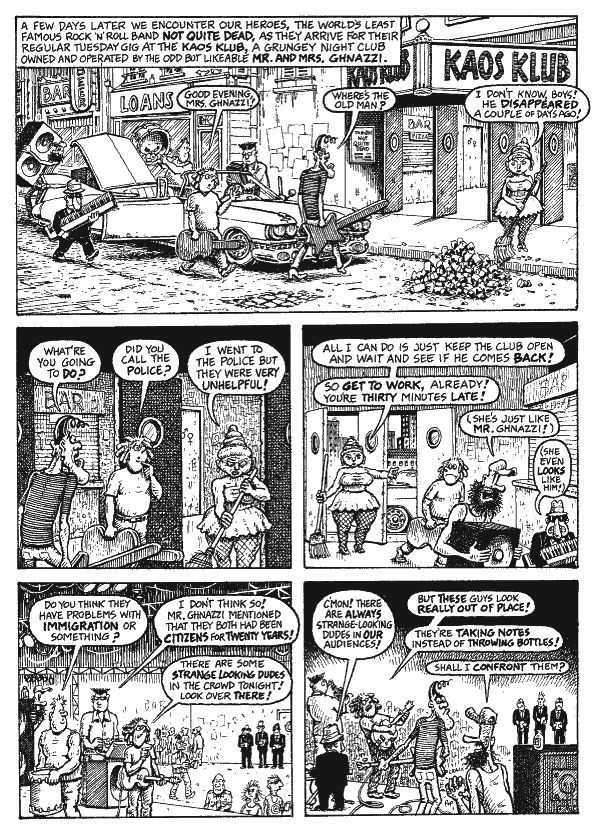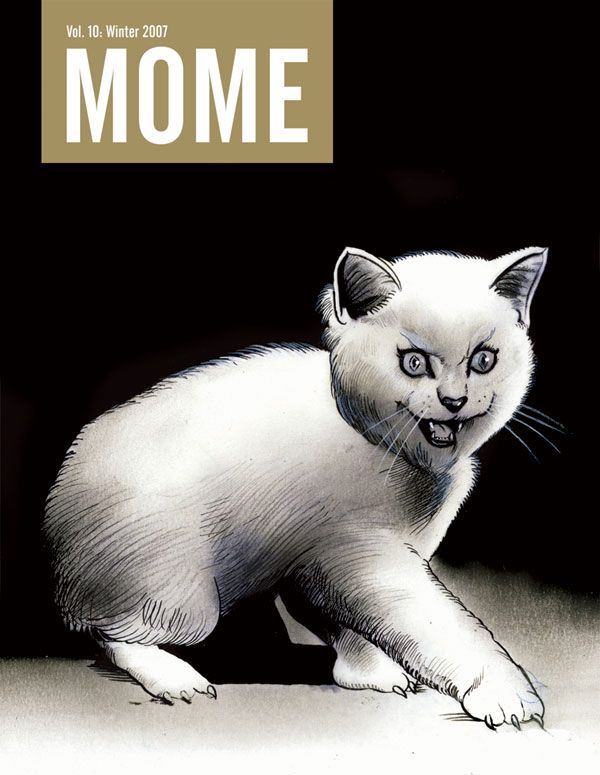"5 years, 20 volumes, 72 artists, and 2,352 pages of comics." Strictly by the numbers -- taken from the Editor's Notes that kick off Mome Vol. 20: Fall 2010, on sale this month -- Fantagraphics' signature anthology is a force to be reckoned with. Launched in 2005 with the intention of providing a regular home for new work by promising young cartoonists like Gabrielle Bell, Jeffrey Brown, Anders Nilsen, Paul Hornschemeier, and Sophie Crumb, it rapidly evolved into something else, something arguably more: a showcase for alternative comics of nearly every style and stripe. During its five-year history, Mome's diverse accomplishments have included publishing work from European greats like David B. and Lewis Trondheim, serializing Tim Hensley's acclaimed graphic novel Wally Gropius, reintroducing Al Columbia to the comics scene prior to the release of his landmark Pim & Francie, giving Dash Shaw yet another forum for his experimental take on science fiction, providing an unlikely venue for underground legend Gilbert Shelton, showcasing up-and-comers like Jon Vermilyea and Nate Neal...and, like all anthologies, starting a good deal of debate over which contributors were any good at all. With its like-clockwork quarterly schedule, Mome is a go-to destination for finding out what's going on at comics' cutting edge.
Presiding over all this has been editor Eric Reynolds, who inherited full control of the anthology from original co-editor and co-publisher Gary Groth. When last I spoke to Reynolds about Mome in October of 2007, he was prepping Vol. 10, which sported a new look, new work from Columbia, and the second half of a story by altcomix titan Jim Woodring. Three years and ten issues later, the series has gotten a full-on makeover from designer Adam Grano, and is in the midst of some of its most challenging work ever from Shaw, Josh Simmons, Derek Van Gieson and more. What has changed, what has remained constant, and what lies in store? Reynolds spoke with Robot 6 about all this and more in a fifth-anniversary interview.
If I'd ask you five years ago to describe what Mome Vol. 20 would look like, what would you have said?
I would've said there's no way this thing's going to last 20 issues. Really, I'm sure I would have had no other answer.
This may be a weird question, then, but how does that sort of belief -- the belief that this thing we're about to do doesn't stand a chance of lasting very long -- affect doing that thing in the first place? What were you hoping for, in terms of how long it lasted? Or did you not really care?
I honestly don't know what I was hoping for. I'm sure I was hoping it could last 20 issues, but realistically, how could I have expected it? Look at any other anthology that's ever been. I'm not sure there's ever been one in alternative comics that's published more pages of comics than Mome. We're at around 2,350 pages of comics thru issue 20. What are the most successful comix anthologies of all-time? RAW? Zap? Weirdo? Zero Zero? Arcade? Kramers? None ever approached that many pages. So I don't think I had a fatalistic attitude going in; it was more of a realistic one. I mean, I know enough from working at Fanta that there are few book series we've ever launched that could sustain 20 volumes. I thought we'd have a decent run but I just don't think I could have anticipated 20 issues.
It's probably been a while since you've been asked this one, but what was the thinking behind the launch of Mome?
Well, there were a lot of specific ideas behind it that I think is well-traveled territory, but really, I just felt like there was a need for an ongoing anthology that came out frequently enough to give a number of cartoonists a platform to publish stories regularly. The periodical market was already shrinking rapidly, and I thought and continue to think that this was not a good thing, creatively-speaking. Virtually every towering alternative cartooning figure I can think of, from Spiegelman to Crumb to Los Bros to Clowes to Ware to Sacco to Chester Brown, etc., honed their craft and found their voice by doing comic books and contributing to anthologies. I knew we were past the point where we were going to be starting too many comic book series anymore and thought an anthology could help fill that void a bit. I had been thinking about it for awhile, and one day Gary and I just started talking about it and decided to do it.
Mome was originally conceived of as featuring a fixed roster of young cartoonists whom we could watch develop over time. That version of the series didn't last very long at all, and since then there have been, I think, several "eras" for the book: An SNL-style "regular cast plus guest star" model, a period where things felt more like underground comics than alternative comics, a period featuring a lot of experimental takes on genre, a slightly edgier feel in the last few issues…If I'm mischaracterizing anything I apologize, but I was wondering how the evolution of the book looked from your vantage point.
You probably have a clearer perspective on it than I do. To me, they tend to blend together at this point. The evolution has been subtle and organic and rarely conscious. I can understand the perception of the eras you've defined, but it wasn't conscious, per se, and I'm not sure I could've ever come up with them on my own.
That makes sense, but were there ever any conscious moves on your part to introduce a sensibility or approach you felt was missing? Like "Hey, you know what we need?"
Well, sure. But not in a broad, overarching sense. For better or worse, it's really more like, "Boy, I really like this, we need this," from issue to issue as opposed to trying to reinvent the entire Mome wheel periodically. I'm not that smart, Sean.
The "name names" portion of the interview: Whose work in Mome are you proudest of?
I'm probably most proud of Tim Hensley, because I've been a pretty big fan of his for going on 20 years now -- I think he was the only early Mome contributor that had also done work for my Dirty Stories anthologies of the mid-1990s -- and I don't think Wally Gropius would exist if we hadn't asked him to contribute to Mome. I don't think Wally was really swimming around in Tim's head until he was specifically asked to contribute X number of pages to Mome per issue and he had to come up with something. And I think that book is one of the great graphic novels of the 2000s, so I can't help but take some pride in that even though it's all Tim's work.
I figured he'd be high on your list. One of the coolest things about that comic is that I think it caught a lot of people by surprise. In the individual installments, I know a lot of people who just thought "Oh, that's a funny Archie parody" or whatever. It wasn't until the collection hit that a lot of people cottoned to what he was up to. For me, it was the incest strip that did it. How early on did you know he was up to something special?
Oh, right away. Page 1. It was clear he was embarking on his Magnum Opus. I'm not trying to sound like Mr. Know-it-All, like I knew this was going to set the world on fire. His work just really resonates with me, I love literally everything about it, it's as close to perfect a comic as anything I can think of in regard to my own, undefined, unconscious Platonic ideal of what makes a good comic. The rest of the world, to a man, could hate it and it would do nothing to shake my faith in it, because I know how much *I* value it. The only thing I've read this year that is on that same plane for me, as a fan, has been Jaime [Hernandez]'s stuff in the new Love and Rockets, [Daniel] Clowes's Wilson, and [Charles] Burns's X'ed Out. For whatever reason, these comics are just right in my wheelhouse.
Now that you mention it, how did your experience with Dirty Stories affect your work with Mome? Tom Spurgeon suggested recently that Vol. 19's strips are the best reminder yet that you were the editor of both books...
That sort of makes sense because 19 is definitely my favorite issue so far and the issue that I think most closely reflects my own tastes as a comics fan. I'm not sure how DS affected my work with Mome, really, other than to give me the confidence that I could do something that others might want to read. They're pretty different titles, though. I was very young when I did Dirty Stories and had a much more reactionary, transgressive streak in me than I do now. Dirty Stories came from a very punk mindset. Mome was a much more idealistic endeavor.
What other contributors have you been really happy with?
I've been extremely proud of what Dash Shaw has done in Mome. I think he's been the perfect Mome contributor in many ways, actively utilizing the format to experiment in a myriad of ways.
He's sort of a cartoonist who's never done the same thing twice, isn't he? I mean, the growth from, like, Love Eats Brains to Bottomless Belly Button...
Yeah, exactly. Trying different genres, experimenting with fiction and nonfiction, playing with color, with technique, and having no fear...The guy is really something else.
I could list any number of cartoonists and what I've liked about their work, but one other who comes to mind that I've been really proud of is Tom Kaczynski. He was someone I met through Gabrielle Bell and I liked his work from the get go but it's only as I've gotten to know him a little bit better and read his contributions to Mome that I've discovered what a smart, thoughtful guy he is. And he has the cartooning chops to match what's going on in his head. I have a feeling there are very few rooms that Tom walks into where he isn't the smartest one in it. The sociopolitical themes he wrestles in his work would in the hands of a lesser cartoonist come off as preachy or dogmatic, but he manages to never do that. I think he has only important work in him.
Did any of your contributors let you down?
As far as who let me down...I don't really want to go there and nobody immediately came to mind, even, although thinking about it a bit I would have to say the biggest disappointment is that David Heatley never finished Overpeck. I think that was shaping up to be a tremendously weird and powerful story and I was eager to see where it was headed.
That's a great call. And not just because what he ended up doing instead was so divisive, but because I really did feel that that was his best work yet. What happened there -- is it something you can go into?
I'm not even sure I remember the specifics. I know I tried very hard to convince him to continue it. If I recall, he had gotten his book deal to do My Brain Is Hanging Upside Down and with it there may have been a deal or an option for Overpeck, as well, and he decided he didn't want to tip his hand any further and simply wait for the collection to publish it. Which was fine, it was his decision, but I just really liked the work and wanted to see it finish in Mome. I haven't talked to David in quite a long time, so I have no idea if it's still in the cards or what.
Who was your biggest get?
I guess I'd have to say David B., Jim Woodring, Al Columbia or Gilbert Shelton. David B. was really key because I think he was the first truly established cartoonist to consent to being in Mome, it was very early on (issue 3) and I think he lent some much-needed legitimacy to what we were doing. I was grateful to Al and Jim, two guys I'd known for over 15 years, to trust me enough to let me run their work, because they could have published anywhere they wanted, I'm sure. Personally, I was probably most excited to have Gilbert Shelton. I get the impression that his pieces didn't go over so well with a lot of Mome readers but holy fucking shit it's Gilbert Shelton! I knew he would be a weird fit for Mome in some ways but I saw it as a real chance to introduce him to a new generation of cartoonists. I think it's not unreasonable to say that Shelton has kind of fallen off the radar when it comes to discussing a pantheon of the all-time greats. Most of his work over the last couple decades from Knockabout and Rip Off seemed to be off the radar of most alt-comix readers. So, as silly as it might sound, I thought he might stand to benefit from Mome as much as any of the younger folks, and certainly more than, say, David B. or Jim Woodring. I also thought his strip was very funny and contemporary despite the superficial hippie trappings that seem to put some folks off. I think if he drew his characters to look like urban hipsters folks would have loved it, which is kind of depressing.
Are there any cartoonists you think of as "the ones that got away," who you wanted to get in the book but couldn't?
There were a few folks who were initially slated to be in Mome's initial core group but had to back out for whatever reasons prior to the first issue. Marc Bell was one, I think Kevin Huizenga was another. I would have been thrilled to publish them in there but it didn't work out.
At Comic Con this year, Brian Ralph told me that he was bummed at the time Mome started because he wasn't asked to contribute. Brian would have been an awesome guy for Mome, so now I'm bummed that I didn't.
I also really miss Jonathan Bennett being in Mome, which I know he knows. I love his work and it felt like he was in a very strong creative groove with the first several issues of Mome and that the best was still yet to come. I think he's a tremendously underrated cartoonist, an impeccable craftsman with a very strong voice. But his career as a graphic designer really took off shortly after Mome began and he hasn't been able to create many comics the last few years. Whether it's for Mome or otherwise, I really hope he gets back to them because he's really, really good.
Do you get a lot of feedback from the artists in Mome about the other artists in Mome? How does their juxtaposition with one another affect the reception of their work, do you think? Have any of them ever offered their thoughts on that?
You'd have to ask them, I guess. I mean, yes, I have gotten and do get feedback from some of the artists about what they like and don't like, and I always enjoy that. But I couldn't tell you much more, specifically. It's not like we all work in a big clubhouse. In fact, I'm often lousy at communicating with Mome artists, which I'm really embarrassed to say, it's really something I wish I was better at. I'd like to think they and the readers enjoy the juxtapositions, and I always try to create interesting juxtapositions within each issue. Rob Clough has a real knack for picking up on those things whenever he reviews Mome.
One thing I've been curious about for a long time is what Mome's audience is like, since it's a format that's very different than anything else out there. Is it people getting every single issue? Subscribers? People who pick individual volumes up depending on who's in them? The audience for the literary journals that inspired it?
I really have no idea. I just don't. I mean, I know where we sell the books, but I don't know who the consumers are, per se. And where we sell Mome is not appreciably different than where we sell most of our books. About half go thru W.W. Norton to bookstores and Amazon and half go thru Diamond to specialty shops. We do have a subscriber base although it's farily minimal, maybe a couple of hundred people.
One slight trend I've noticed and which has been pretty gratifying is that a lot of cartooning students tell me they read it. I've taken trips in the last couple of years to places like MCAD and CCS and I'm really gratified to have a surprising number of aspiring cartoonists tell me how much they really enjoy it. I like that. When we started Mome, the idea was essentially to help the cartoonists who were in it. If it actually somehow serves as some kind of inspiration or influence to cartoonists who aren't even in it, then that's a really great fringe benefit that never even occurred to me as a possibility when we started.
That's interesting. It's not as though I have any contact with cartooning students whatsoever, but i wonder if it's seen as sort of the Big Leagues, the way people at the sketch and improv institutions in New York and Chicago and L.A. and so on see Saturday Night Live. That's why I've pitched to it, I could tell you that much.
Maybe. I imagine it's maybe something they see as both the Big Leagues but yet also attainable, if that makes sense.
If I'm not mistaken, Vol. 20 marks your debut as the sole editor of the series.
I've actually been the sole editor for quite awhile. I forget what issue Gary's name came off the masthead but it's been several.
Oh, look at that -- it was Vol. 17, Winter 2010. How had you and Gary split the work, and what's changed now?
This might sound self-serving, I really don't mean it to, but I was always doing the heavy lifting on Mome even though we consulted together on everything early on. Gary always has too much to do. It got to the point where I was making a lot of decisions without even consulting Gary because he's a Very Busy Man and I didn't want to bother him with too many details, and at some point he suggested to me that I take his name off the masthead because he felt guilty about taking co-credit. So I did. The division of labor early on was simply that we both invited cartoonists to contribute and that I did most of the nuts and bolts assembly of the book while he contributed the interview every issue. It was a lot of fun because even though I work ten feet apart from Gary we hadn't really collaborated on a project like this since I was an editor for The Comics Journal in the early-to-mid 1990s.
This issue sees a redesign, the biggest since Jordan Crane designed the very first installment. I know the layout was altered at issue #10, removing the two-tone wallpaper-style patterns and moving the title from a bar at the bottom to a box in the upper left, but the logo remained the same. Why change what turned out to be a pretty iconic design?
Well, I guess it came down to, "Why not?" It's not like Mome has ever been hugely successful, and it shouldn't come as too much of a surprise when I say that after 20 issues, sales have flattened out a bit. Adam Grano has been doing the production and design for Mome since almost the very beginning, adhering to Jordan's template. He's done a great, unsung job considering -- let's face it -- it can't be as creatively satisfying adhering to someone else's template is it would be to create your own. So when Adam proposed redesigning the series a few issues back, even though the obsessive-compulsive in me resisted the idea, the more I thought about it and the more it seemed like a good idea. So I gave him the green light for issue 20, which seemed like a good "anniversary" issue to do it with. We'd made a slight design change with issue 10, eliminating the title bar across the bottom and eschewing the patterned backgrounds, so 20 seemed like a good place to mix it up even further. It enabled Adam to put his stamp on it a bit. If Mome was a tremendous commercial success I would've likely been more resistant to it. I love The Believer and love that they've stuck to their template for 70-some issues now. Charles Burns is their David Levine. I love that kind of continuity personally. But it felt right to resist those inclinations and try something different.
Anthologies are a dicey business in comics. To what do you attribute Mome's longevity?
Just enough sales. I realize you're really asking me, "To what do you attribute just enough sales to?" and to that end I really have no idea. I'm just grateful it's hung on.
Fair enough! Speaking of anthologies, though, where do you see Mome in relation to some of the other approaches to that format over recent years -- Kramers Ergot or Papercutter or D&Q Showcase?
Well, I'll be the first to admit that Mome is hardly as tightly-curated or as well-conceived as the last few Kramers. That's like the gold standard for anthologies at this point. But one of the great benefits of Mome is, for me, its frequency. I very purposefully created with Jordan Crane a template that would enable me to be able to get issues out every three months. I work on Mome as a labor of love, I do it on the side for no pay, and to be able to do that, I simply couldn't be as hands-on and as detail-oriented as Sammy [Harkham] has been with Kramers. You'll never see me flying to Malaysia to watch Mome come off the press. I wish that wasn't the case, but I would've burned out after a few issues. So I see Mome's great strength as being its periodicity, as superficial as that might sound, but it really was a key component of the idea behind it, that by doing four issues a year with four deadlines, the contributors might be pushed to create more pages than they otherwise would, and try things they might not otherwise have done.
There does seem to be a bit of a renaissance of good anthologies lately. Smoke Signals from Brooklyn's Desert Island, Diamond Comics from Floating World in Portland, some of the stuff Sparkplug has been doing, student work from CCS and SCAD, etc. I don't know where Mome fits in it all, really. I just hope enough people enjoy it on its own terms to justify its existence. When there isn't enough, we'll end it. I'm not too precious about it.
Bizarrely, I'd never thought of the anthologies of the past few years as a replacement for the solo alternative comic book until just now, when you mentioned how Mome was a response to the latter's disappearance. Now, of course, it makes perfect sense: If you're not one of the very few artists continuing to pursue that format, perhaps quixotically -- Kevin Huizenga seems to have made the most successful go of it recently, and Michael DeForge seems to mean business about it -- an anthology makes sense as a way to work frequently in print, in front of an audience. Did you get a sense from your artists that that's how they saw it as well?
I think so, yeah. I mean, that was really the explicit intent of it being quarterly. And I think you're right about Kevin, he's one of the Last Men Standing as far as that goes, the exception to prove the rule. There were always anthologies, even when the periodical market was thriving, but I think they're even more valuable now. There are just not enough publishers to support all the good cartoonists out there. I am constantly having to reject some pretty good work because we just have a ceiling of how many books we can publish a year. It's my least favorite part of the job. Mome is at least a small way to help offset that reality.
Related question: It can be argued that web publishing can serve the same purpose that the solo series used to serve, or that the print anthologies serve today. Lately we've been seeing a lot more work from established alternative cartoonists going up online, from Brian Chippendale to Frank Santoro to Gabrielle Bell to everyone on Jordan Crane's What Things Do, which is a real murderer's row. As an editor of a print anthology dedicated to that sort of material, how do you see the rise of the alternative webcomic?
Well, it's a good question, because you could argue quite easily that a good cartoonist could pretty easily find as large an audience -- and quite possibly a significantly larger one --- online as they would contributing to something like Mome. I harbor no illusions about that. But I also think there's still something to be said for preparing your work for print, seeing it printed in ink, on paper, that validates the work.
This may "out" me as an old man clutching to dying technologies, but I grew up wit print and love its tactile thrill. What the internet now delivers in instant gratification and access it lacks in stirring that fetishistic affection in my soul for print and paper and black, black ink. Evolution has already eliminated this gene from younger generations; it was a largely 20th century anomaly in humankind. Personally, even though I don't make a lot of minicomics or zines anymore, I would still rather do a minicomic than a webcomic. Preparing something for print and making a physical object should be a part of the whole creative experience, it seems to me. When something only exists a screen it doesn't feel like the physical effort of drawing a comic amounted to anything real. Printing is an inherent component of the history of cartooning and comics. Removing that from the equation will make cartooning a different thing in the 21st century, as different as ragtime and electronic music. I am personally invested in keeping the tradition of hand-drawn and physically-printed cartooning alive.
That's not at all to dismiss the Internet or webcomics, which is clearly become a vital component of the contemporary comics scene, and is probably a more valid path for many cartoonists than pursuing print, and digital will win out in the very end. I understand and accept the whole "adapt-or-die" and think about it daily in my larger position here at Fantagraphics. I love Jordan's site and think it's the best thing going on the web, and it bodes well for the future of webcomics. But I still, simply, see a value in print, and think both ends can coexist peacefully. I mean, I know Jordan, for all of the work he's put into What Things Do, still ultimately sees the web as a means to end for the eventual print collections of his work. The books are still the Thing in What Things Do.
What does the future hold for Mome?
Well, I'd like to say 20 more issues, but I honestly don't know. I take it very much issue to issue. I'm starting to put together 21 now. Tom Kaczynski and Kurt Wolfgang are back, which is exciting to me, I love those guys. I think Kurt's the last remaining contributor whose been with Mome since issue 1. And [Wolfgang's story] Nothing Eve is going to be a fantastic book when it's done. Sara Edward-Corbett just turned in a story that blew me away, it's her most gorgeous piece ever, very Gorey-esque yet still unmistakably Sara. Josh Simmons' crazy White Rhinoceros serial is just getting started. And lots of other stuff, of course.


